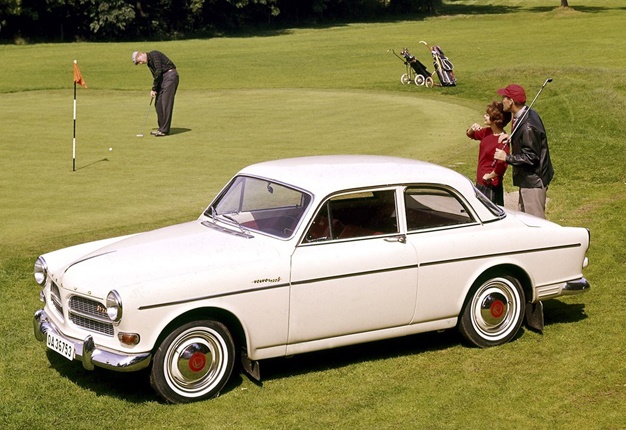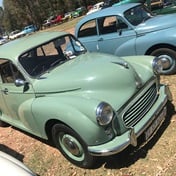
Volvo’s iconic Amazon was introduced 60 years ago, and according to the automaker the last one was built in Sweden in July 1970. Not so, reports Ferdi de Vos, the last Amazon ever built was assembled in SA… and is still ‘lost’.
Cape Town - Never leave a (wo)man behind. That’s the unwritten rule of all elite fighting units.
Yet, it seems a quite important, and unique, member of the Amazons, named after those fierce female warriors in Greek mythology, who has been “left behind” – still lost somewhere, presumably in South Africa.
No-one seems to know where she is, or how she is doing. But she’s quite important, and needs to be rescued… as she’s the actual last one of her kind.
The Volvo Amazon, known locally as the 122, was introduced to the world exactly 60 years ago. The iconic model premiered in the Swedish town of Örebro in September 1956.
READ: Here's how much the new Volvo S90 will cost in SA
Produced over a period of 14 years – from 1956 to 1970 – a total of 667 791 rolled off assembly lines in Sweden, Canada, Belgium… and in South Africa.
According to the Swedish automaker the last Amazon rolled off the assembly line at Volvo’s Torslanda plant on 3 July 1970. This car, a dark blue 122 model, went straight to the car collection that later became the Volvo Museum.
Last Amazon ever was built in SA
However, it seems the Swedes have forgotten about the 300 or so CKD (completely knocked down) kits sent to the Motor Assemblies plant in Durban, South Africa, in that year.
This batch, with a T-production number (indicating it was 1970 model year P130 two-door derivatives) and chassis numbers ranging from about 359700 to 359918, was the last to leave Torslanda.
Gallery: Volvo Amazon
They were assembled in Wentworth from August to December that year, and on 18 December 1970 the last one – a beige two-door 122S model with 1 986cc four-cylinder B20B engine and M40 four-speed manual gearbox – came off the assembly line.
The car was handed over by John Sully, CEO of Motor Assemblies, to Dion Lardner-Burke, marketing director of Lawson Motor group, the importers of Volvo, at the time.
According to Deon van Loggerenberg, chairman of the Volvo Owners Club of South Africa, about 230 of this final batch of right-hand drive 122S models assembled locally were registered as 1971 models, making them very unique.
The last Amazon wasn’t sold initially, but was used as a company car by the Lawson Group.
However, it isn’t clear what happened to it when the assembly of Volvos in Durban ended in 1973.
Shortly after this (in 1976) Volvo pulled out of the country, and with this all track of the last Amazon was lost.
“Some of the final batch survived, and we have a few examples in the club. But we don’t know what happened to the last Amazon, and up until now we haven’t been able to locate it,” Van Loggerenberg said.
“This Volvo, wherever it is, or whoever has it, is important within the context of South African motoring history,” he added. “Being the last Amazon ever built, and also being a right-hand drive model, further adds to its value.”
Amazon history
The Amazon was Volvo’s second post-war model, following on from the PV444. It was initially named Amason, but prior to start of production in 1957 it was changed to the more internationally viable Amazon.
As the German motorcycle manufacturer Kreidler had a moped called Amazone, Volvo could not use the name in some key markets.
With the exception of some Nordic markets, the standard four-door model in the 120 series was known as the 121, with the 122 the sportier derivative, later followed by an S-model.
The standard estate model was called 221, while 222 was used for estates with sports engine, and the 130 was a two-door sedan version. However, nowadays the car is known as the Amazon around the world.
The Amazon was designed by 26-year-old Jan Wilsgaard who went on to become Volvo’s head of design for many years, designing the 140, 240 and 700 series, as well as parts of the 800 series.
The first Amazon models were incredibly elegant, and between 1957 and 1959 all cars were painted in two-tone combinations of black, midnight blue or ruby red body colours with a light grey roof, or a light grey body with a black roof.
From 1959 it became single-tone, and 1961 was the final year of two-tone production.
In 1958 the more powerful Amazon Sport with twin SU carburettors and a sharper camshaft, delivering 63 kW, was introduced and in 1959 Volvo’s patented three-point seatbelt became a standard feature in the Amazon – a world first.
February 1962 marked the introduction of the Amazon estate and in 1967 the sportiest version of the Amazon, the 123 GT, followed.
The 123 GT, which borrowed its engine from the 1800S sports car, offered 86 kW and overdrive. The wing mirrors were attached to the front fenders, extra lights came as standard and a tachometer was mounted above the dashboard.
Despite the introduction of the Volvo 140 series in 1966, development of the Amazon continued. In 1969 both the Amazon and the 140 series received the new B20 engine with better torque and a slight increase in power.
With a total of 60 percent of Amazons sold outside Sweden it switched Volvo’s focus from the domestic market to the export market. It was also the first Volvo model to be assembled outside of Sweden.
In 1960 South Africa was the first country to receive an assembly contract. Motor Assemblies started with production of the 544, but then quickly changed to the then new 122S, assembled with right-hand drive in sedan, and later also estate, form.
In total, from 1960 to 1973 Motor Assemblies assembled 7 382 four-door (P120), 1 008 Estate (P220) and 5 568 two-door (P 130) models. Assembly was then relocated to the SAMAD (now VWSA) plant in Uitenhage, before Volvo pulled out of South Africa.
In 1963, Volvo also opened a plant in Halifax, Canada, from 1962 to 1966 Amazons were also assembled in Arica, Chile, and from 1965 in the Belgian city of Ghent.
Interesting Amazon facts
- Besides the last Amazon in the world being assembled in South Africa, the Volvo 122 was very successful in local motorsport under the Lawson Motors banner. Francis Tucker and Raggy Schjolberg won the 1966 SA Rally Championship in a Volvo 122S, and in 1967 Jan Hettema and Robbie Broekmeyer repeated the feat.
- In 1966 Jan Hettema and Christo Swanepoel participated in the Monte Carlo Rally with a 122S. Hettema also won the inaugural Roof of Africa Rally in 1967 with a Volvo 122S.
- In 1968 and 1969 Volvo won the Manufacturers’ Category of the SA Rally Championship with the 122S.
- From 1966 to 1968 the Amazon also did very well in the legendary Kyalami 9-Hour Endurance races, scoring class and Index of Performance wins.
- Around eight per cent of the approximately 297 000 Amazons sold in Sweden are still around. The most common is the 1966 model, of which 4804 are still registered. In total, there are 24 282 Volvo Amazons still registered in Sweden.
- Volvo’s factory driver, Carl-Magnus Skogh, won the 1965 Acropolis Rally in Greece driving a 122S.
- The Swedish police cooperated with Volvo, and jointly developed equipment that was later included on ordinary production cars. The police cars featured disc brakes, brake assist and radial tyres several years before they became common in production cars. The police Amazons were equipped with rear window fans. There was a button by the steering wheel connecting the windscreen cleaner with the fastest windscreen wiper setting.
- Colin Powell, the USA’s former Secretary of State and Chairman of the Joint Chiefs of Staff, has owned several classic Volvos, including a 1966 Amazon estate. When he left his post in 1993, he was given an Amazon in dire need of renovation by President Bill Clinton and Vice President Al Gore.
- The 1963 Geneva catalogue featured a Volvo 122S Cabriolet created by the Belgian coach builder Jacques Coune. The catalogue gave the impression that it was a production car, but Volvo had nothing to do with the initiative and only four were built.
- Advertising man Amil Gargano of New York took on the Volvo account in 1962. He concluded that Volvos could withstand practically anything, and this became the brand’s USP. An advertising film shows an Amazon being driven hard on gravel roads. The advert’s payoff is just as clear as it is impossible today: “And you can drive it like you hate it. Cheaper than psychiatry”.
- There were plans to put a V8 in the Amazon – an evolved version of a truck engine. Five prototypes were said to have been built, but in the end Volvo’s management decided a V8 was not suitable for the Amazon.
- When Volvo’s range of models expanded thanks to the Amazon, Volvo regained its position as Sweden’s best-selling car brand in 1958. This is a position it has retained every year since then




 Publications
Publications
 Partners
Partners
















